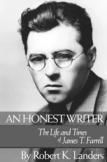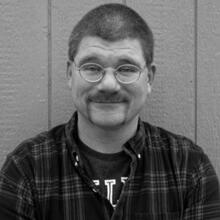Brutal Realist
In 1999, the Modern Library joined the frenzy for Best of lists, naming the top 100 English-language novels of the 20th century. James T. Farrell came in at number 29 with his Studs Lonigan trilogy: Young Lonigan, The Young Manhood of Studs Lonigan and Judgment Day. Amid the subsequent sound and fury, which such lists inevitably provoke, a question asked by many critics was: Who even reads James T. Farrell these days? Well, as Farrell, who died in 1979, would have turned 100 this year, it appears he is holding up quite well.
The Lonigan trilogy was recently reissued by The Library of America. A diverse group of writers, including Pete Hamill, Norman Mailer and Ann Douglas sang Farrell’s praises in a discussion at the New York Public Library in March. Now we have an excellent new biography, An Honest Writer: The Life and Times of James T. Farrell, by Robert K. Landers, a senior editor at The Wilson Quarterly. It is the most authoritative we have yet on Farrell’s life and work; and yet even Landers reflects the literary schizophrenia surrounding Farrell and his famous trilogy.
The Lonigan books have fallen into neglect, Landers arguesa tough sell, given Farrell’s showing on the Modern Library list. Yet Landers is correct to say the trilogy was by far Farrell’s best creation. But he does not thoroughly wrestle with an equally important question: Did Farrell’s escape from the lower-middle-class Irish world he loathed distort his depiction of that world?
According to Landers, Farrell’s young and tragic protagonist was a victim of what Farrell often called the spiritual poverty’ that surrounded him, but he also fell victim to his own poor choices during his short life. But while there are some sympathetic characters in the Lonigan trilogy, particularly the budding writer Danny O’Neill (who would have five books devoted to him down the road), it’s hard to escape the fact that, through Studs, Farrell was revolting against his particular village. The books ultimately suggest that one had to escape Irish Chicago or die, an excessively bleak vision, which plagued Catholic ethnic books (and films) throughout the 20th century.
And yet the Lonigan books remain the great novels thus far of the Irish American experience.
Landers skillfully mines Farrell’s additional fiction to suggest revealing facts about the writer’s life. An Honest Writer spends too much time on arcane battles between leftist camps of the cold war era. Yet Landers is right to note that, to Farrell’s credit, he believed many fellow radicals, who loudly railed against convention, had simply fallen for a new religion, St. Bohemia (Farrell’s words).
Farrell was born in a four-story flat on Archer Avenue in 1904, in the city made infamous two years later by the publication of Upton Sinclair’s The Jungle. In Farrell’s Chicago, one-third of the population was foreign born and more than three-fourths had immigrant parents. It was Farrell’s grandfather (also James) who left Tipperary around the time of the Irish Famine, and roamed the states before settling in Chicago, just when labor was in great demand following the Great Fire of 1871.
Landers effectively outlines the most significant event of young Farrell’s life, a psychic wound that turned out to be inseparable from the creative strength of the novelist to come. With six other children ultimately to tend to, Farrell’s parents sent him to live with relatives in a much more tumultuous household. Such personal strife marked Farrell surely as much as the politics of Chicago. Nearly 60 racially motivated bombings took place between 1917 and 1921, according to Landers, the kind of tension Farrell recorded so vividly, which was the product of racism prevalent in Northern ethnic neighborhoods during the Great Migration.
Farrell’s political views formed as he attended evening college classes, while also pumping gas. He eventually made his way to New York City, where he read that giant of American realism Theodore Dreiser and experienced the Sacco and Vanzetti executions. But soon Farrell was back home, where he met the woman he would marry not once but twice, Dorothy Butler.
After making a name for himself with the stark realism of the Lonigan books, Farrell left Butler for a striking actress/model, with whom he would have two children, one of whom was severely retarded, precipitating that marriage’s decline. Farrell remarried Dorothy when he was more mature and established, though far from wealthy or settled.
Indeed, despite publishing some 50 books, Farrell, as Landers makes clear, always felt ill-treated by publishers and critics. And in a sense he was. Farrell wrote far too much and was a terrible editor of his own work. But this did not prevent him from openly lobbying for the Nobel prize. In the end, these sinsenvy, ambition, troubles with lovers and childrenare the sins of many writers.
Yet Farrell rarely wallowed in his misery. Of early publishing rejections he wrote: It is very discouraging...but I don’t see that it does me any good to feel martyred. Landers also argues persuasively that Farrellthough a committed socialist who more or less renounced his religious and ethnic backgroundnevertheless emerged as an indisputably Catholic writer, to use Philip Rahv’s words. These tempered views somewhat make up for Farrell’s ideologically blinkered (Landers’s term) isolationism as World War II approached. Ultimately, Farrell’s trajectory from 1930’s radical to 1960’s supporter of Vietnam, who realized he had been too harsh on his nation and church, was not unfamiliar.
But should Farrell still be read? Certainly the Lonigan trilogyas well as the five O’Neill books, for all their excessive heftremain relevant. After all, assimilation and the experiences of urban ethnic males continue to pose important political and cultural questions, as do the methods artists use to explore those questions. Farrell’s fans, therefore, should commit themselves to persuading readers that he is as important to this century as he was to the last one.
This article also appeared in print, under the headline “Brutal Realist,” in the October 25, 2004, issue.








